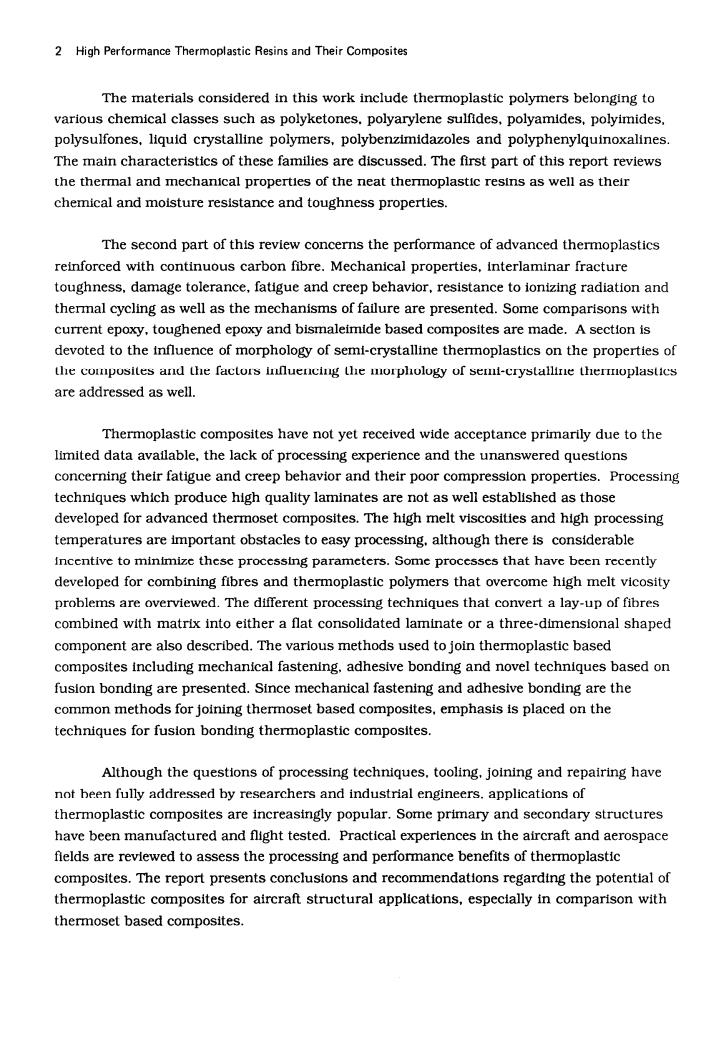正在加载图片...

2 High Performance Thermoplastic Resins and Their Composites The materials considered in this work include thermoplastic polymers belonging to various chemical classes such as polyketones.polyarylene sulfides,polyamides,polyimides. polysulfones,liquid crystalline polymers,polybenzimidazoles and polyphenylquinoxalines. The main characteristics of these families are discussed.The first part of this report reviews the thermal and mechanical properties of the neat thermoplastic resins as well as their chemical and moisture resistance and toughness properties. The second part of this review concerns the performance of advanced thermoplastics reinforced with continuous carbon fibre.Mechanical properties,interlaminar fracture toughness.damage tolerance,fatigue and creep behavior,resistance to ionizing radiation and thermal cycling as well as the mechanisms of failure are presented.Some comparisons with current epoxy,toughened epoxy and bismaleimide based composites are made.A section is devoted to the influence of morphology of semi-crystalline thermoplastics on the properties of the composites and the factors influencing the morphology of semi-crystalline thermoplastics are addressed as well. Thermoplastic composites have not yet received wide acceptance primarily due to the limited data available,the lack of processing experience and the unanswered questions concerning their fatigue and creep behavior and their poor compression properties.Processing techniques which produce high quality laminates are not as well established as those developed for advanced thermoset composites.The high melt viscosities and high processing temperatures are important obstacles to easy processing,although there is considerable incentive to minimizc thesc processing parameters.Some processes that have been recently developed for combining fibres and thermoplastic polymers that overcome high melt vicosity problems are overviewed.The different processing techniques that convert a lay-up of fibres combined with matrix into either a flat consolidated laminate or a three-dimensional shaped component are also described.The various methods used to join thermoplastic based composites including mechanical fastening,adhesive bonding and novel techniques based on fusion bonding are presented.Since mechanical fastening and adhesive bonding are the common methods for joining thermoset based composites,emphasis is placed on the techniques for fusion bonding thermoplastic composites. Although the questions of processing techniques.tooling.joining and repairing have not been fully addressed by researchers and industrial engineers.applications of thermoplastic composites are increasingly popular.Some primary and secondary structures have been manufactured and flight tested.Practical experiences in the aircraft and aerospace fields are revlewed to assess the processing and performance benefits of thermoplastic composites.The report presents conclusions and recommendations regarding the potential of thermoplastic composites for aircraft structural applications,especially in comparison with thermoset based composites.2 High Performance Thermoplastic Resins and Their Composites The materials considered in this work include thermoplastic polymers belonging to various chemical classes such as polyketones. polyarylene sulfides, polyamides, polyimides. polysulfones. liquid crystalline polymers, polybenzimidazoles and polyphenylquinoxalines. The main characteristics of these families are discussed. The first part of this report reviews the thermal and mechanical properties of the neat thermoplastic resins as well as their chemical and moisture resistance and toughness properties. The second part of this review concerns the performance of advanced thermoplastics reinforced with continuous carbon fibre. Mechanical properties, interlaminar fracture toughness, damage tolerance, fatigue and creep behavior, resistance to ionizing radiation and thermal cycling as well as the mechanisms of failure are presented. Some comparisons with current epoxy, toughened epoxy and bismaleimide based composites are made. A section is devoted to the influence of morphology of semi-crystalline thermoplastics on the properties of the composites and the factors influencing the morphology of semi-crystalline thermoplastics are addressed as well. Thermoplastic composites have not yet received wide acceptance primarily due to the limited data available, the lack of processing experience and the unanswered questions concerning their fatigue and creep behavior and their poor compression properties. Processing techniques which produce high quality laminates are not as well established as those developed for advanced thermoset composites. The high melt viscosities and high processing temperatures are important obstacles to easy processing, although there is considerable incentive to minimize these processing parameters. Some processes that have been recently developed for combining fibres and thermoplastic polymers that overcome high melt vicosity problems are overviewed. The different processing techniques that convert a lay-up of fibres combined with matrix into either a flat consolidated laminate or a three-dimensional shaped component are also described. The various methods used to join thermoplastic based composites including mechanical fastening, adhesive bonding and novel techniques based on fusion bonding are presented. Since mechanical fastening and adhesive bonding are the common methods for joining thermoset based composites, emphasis is placed on the techniques for fusion bonding thermoplastic composites. Although the questions of processing techniques, tooling, joining and repairing have not been fully addressed by researchers and industrial engineers, applications of thermoplastic composites are increasingly popular. Some primary and secondary structures have been manufactured and flight tested. Practical experiences in the aircraft and aerospace fields are reviewed to assess the processing and performance benefits of thermoplastic composites. The report presents conclusions and recommendations regarding the potential of thermoplastic composites for aircraft structural applications, especially in comparison with thermoset based composites